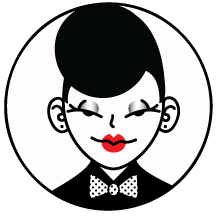Mykki Rios, a non-binary Mexican American, with gold-orange eye makeup and pink and orange hair, poses face-on for the camera in a dark green shirt.
Mykki Rios is a queer genderfluid Mexican-American poet, performer and multimedia artist. Raised in Chicago, and having lived many places across the globe, Mykki has had works featured in issues of Welter, Meat For Tea: The Valley Review, Random Sample Review, Smoke and Mold Journal, Lupercalia Press' Vulcanalia anthology, and more. They were also a finalist in Lupercalia Press' 2022 Chapbook Series Contest.
Elizabeth Kumaki, a non-binary biracial Japanese American, poses with one hand on their shoulder in dark purple and black makeup, a long black veil, a black hand stitched smock pinned with silver penannular brooches and belted with a black leather belt supporting a black leather pouch, black leather gauntlets, and silver and pewter chain and skeleton jewelry.
Elizabeth Kumaki is a queer non-binary Japanese American fashion and textile artist, actor, and musician living in Seattle, Washington. Their work has been featured on stage, television and by independent artists for performances and photos. You can find them on instagram @seaweedxseed.
chemise a la cottagecore
mykki rios and elizabeth kumaki
The cut of the gown in this series became famous in the western world in a 1783 portrait of Marie Antoinette by Elisabeth Vigée-LeBrun. While it was already well known in certain oppressed cultures, the portrait of Antoinette saddled this garment with the moniker “chemise a la reine” or “chemise of the queen” which would serve to connect the dress, Antionette, and a comparison to the chemise (an undergarment) for more than two hundred years.
Antoinette popularized this cut of dress in European culture when she started wearing them to vacation at her country houses (which were entirely ornamental and designed to look like rural villages). She liked to pretend she was a simple country shepherdess, but the inspiration likely came from fashionable and practical hot weather churchgoing and socializing dresses worn by free and enslaved creole women living in Haiti, better known as the “robe a la creole” (but this is also a French term and thus also outsider nomenclature). It is notable that the dress was made from cotton which had to be imported to France and was likely coming from the work of enslaved people in what is now the US or subjugated people in India.
Mykki poses in the chemise, lucite heels, and large hat with some miniature pumpkins in front of terraced public park landscaping and a set of concrete stairs.
The “cottagecore” aesthetic has much in common with the history of the robe a la creole in that it is an expensive and shipping-heavy colonial appropriation of an idealized working-class “pastoral” lifestyle. Cottagecore fashion and photography is meant to transport the viewer to an apocryphal cottage where a fresh baked pie cools on the windowsill as stew bubbles on the hearth, fresh cut flowers arranged jauntily in a mason jar rest on a wooden table, and beautiful women in spotless aprons delicately hold teacups with soft, manicured fingers without a speck of dirt beneath their nails. The only ants at their daily picnics in the sun live within the whimsical embroidery on their linen napkins. The horses shovel out their own stalls lest they get a speck of dirt on the cottage owner’s neatly pressed overalls. It doesn’t matter that the clothes were all made from polyester in a sweatshop for a drop shipping company and sent thousands if not hundreds of thousands of miles to be worn once in a photo by their final recipient and then discarded to live on for centuries in a landfill and millennia as microplastics. Cottagecore, like the chemise a la reine, is about fantasy first and foremost.
Detail shot of the hand stamped peach and eggplant print around the bottom edge of the skirt. Mykki is no longer wearing the hat and instead is gently draped with a scarf that matches the darkest parts of the ombré dress.
The use of harsh urban backgrounds with small pockets of vegetation in the photos of this “chemise a la cottagecore” was intended to intensify the theme of disconnect with nature as an active experience in favor of connection to it as an aesthetic. The plants serve as props and set and the structured but unmanicured look of the municipal vegetation reflects the artificial intentions of cottagecore’s faux pastorality. This uncanny connection to a perfected and digitized version of nature is reinforced with the intentional clash of seasons. The dress itself is a spring gown but is presented in a summer resort color palette and decorated with images of summer produce. The set is decorated with pumpkins and fall foliage. The images are disconnected from any real experience of pastoral life while also displaying many of the main themes of cottagecore.
This garment was both stitched by hand and on a vintage Singer. Over twelve meters of cotton voile were dip dyed by hand using RIT dyes, stamped with peaches and eggplants using Speedball fabric ink, and gathered down into a wearable gown meant to evoke the fresh and fruity “farmer’s market” aesthetics of cottagecore while still largely staying true to the original pattern for the robe a la creole. Each line of gathers is fully adjustable using drawstrings allowing for a comfortable fit over many different types of undergarments ranging from drag padding to a basic slip or bare skin. This particular shoot features minimal padding but a strong, corseted understructure.
Mykki wears the chemise and hat atop a retaining wall in a terraced public park in front of a steakhouse with colorful foliage framing the bottom edge of the photo.
We approached the design and drag styling of the garment to be less in line with “female impersonation” but instead in connection with the larger, more fluid drag tradition of simultaneously honoring and parodying ideas from art, history, fashion and current trends. The hat is massive because it’s both more elevated and comedic that way. The shoes are tottering, towering lucite heels precisely because they’re impractical and unrealistic for any outdoor activity, a touch of contemporary drag aesthetics sneaking in. The wig is a dusty rose hair color that’s decidedly 2020s for the same reason. Peaches and eggplants were our chosen stamps because they reference sexually—and specifically queer—coded emoji. Everything is intended to be both backward and forward looking, always winking and nodding at every point that can be linked to other ideas. Something so self-aware, so detail oriented, that it’s new and entirely unencumbered fun.
Mykki poses in the chemise, lucite heels, and large hat with some miniature pumpkins in front of terraced public park landscaping and a set of concrete stairs.






